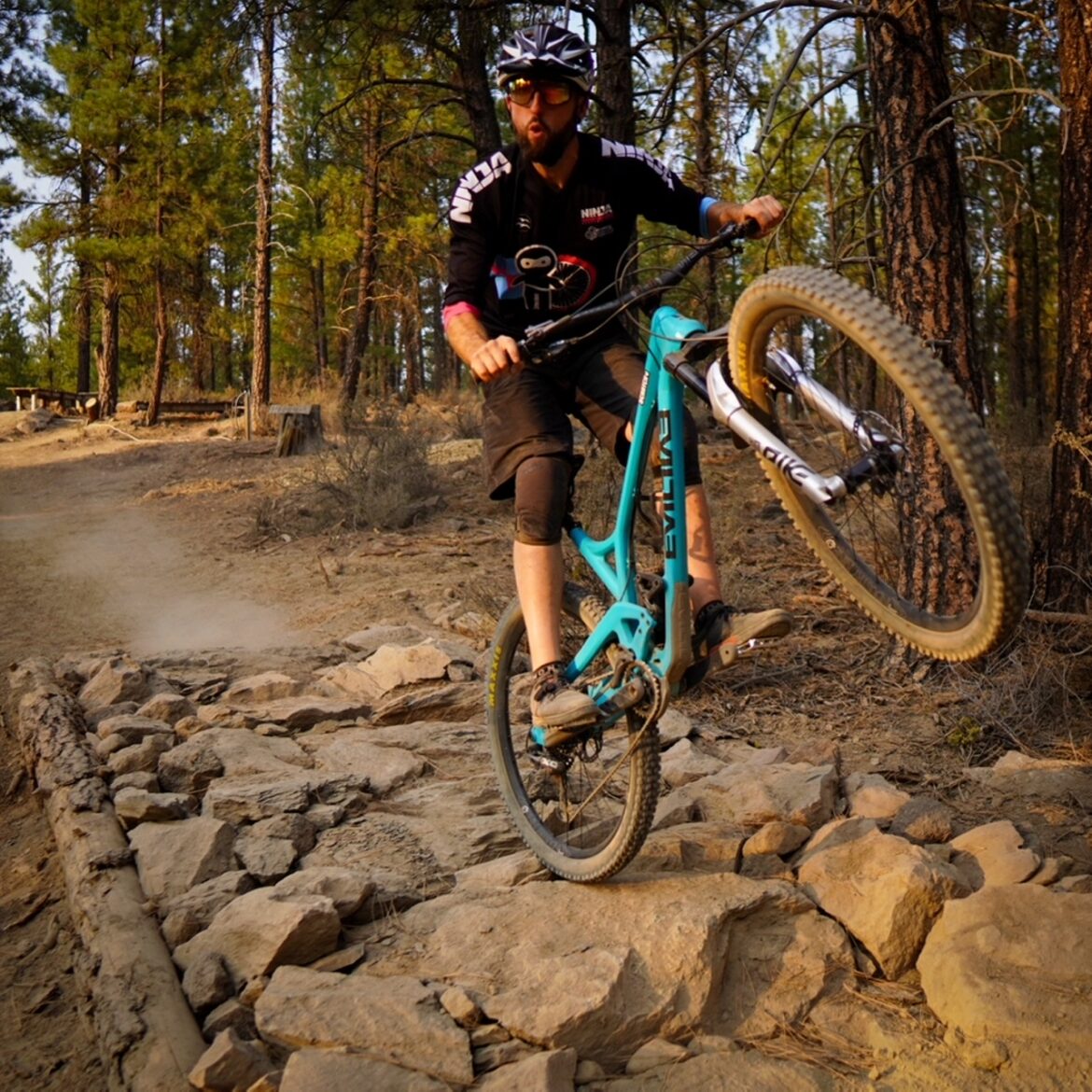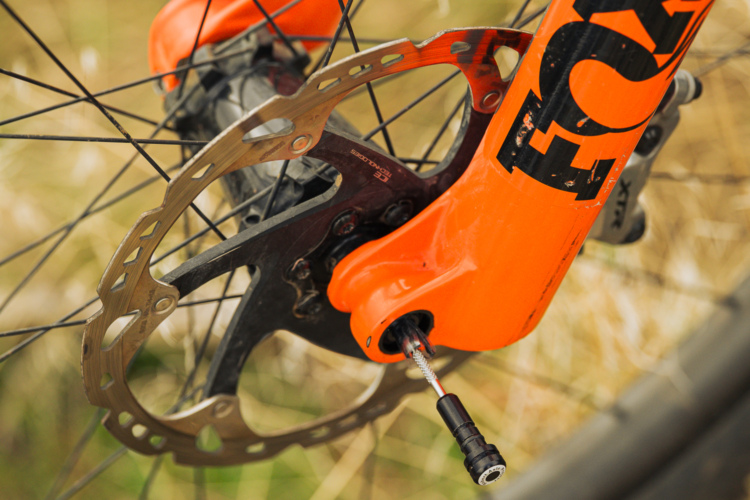
Once, the term “rock garden” conveyed tranquil images of serene oriental gardens in my mind. Thanks to the twisted minds of today’s trail builders, hearing the term now sends terrifying images of jagged rocks ready to rip me to shreds flashing through my brain.
To help me and other riders get over our fears of riding rock gardens, I reached out to Jeremiah “Scratch” Stone for help. Stone is an accomplished MTB instructor and master trail builder who works with Ninja Mountain Bike Performance. As always, he provided some great tips.
Conquer your fear of rock gardens by running drills
For me, seeing a rock garden ahead puts me on edge. That’s a bad way to enter a rock garden according to Stone. “Think of what fear does to the body and mind on the bike,” he says. “If we are scared or surprised then we tend to close in our arms and legs and try to get away from the scary thing by pushing our weight back. Then we hold our breath and get stiff.” These actions contradict the ideal body position and movement for attacking technical trail features like rock gardens.
Stone states that the only way riders can eliminate these reactive movements is by practicing the correct movements on purpose. “Focus in on that low, ready position. Maintain bike/body separation and keep your eyes up.” Before trying them out on rock gardens, riders should run drills in controlled environments that are low risk. “Go from high-ready position to low-ready position while keeping the eyes up and making sure you are going down and not back with the hips. Next, rock the bike back and forth as far as you can while keeping the torso stable. Then shift your hips as far back as you can (butt buzz) and as far forward as you can.”
Stone also suggests practicing by going off a curb, over small roots, or down a few steps while keeping your torso and head stable. “Ideally, it should appear that your body is on a zip line and your arms, legs, and bike are doing all the movement.”
Make sure you have the proper bike set-up
Stone says riders should make sure their bikes have solid baseline settings before they start making adjustments for riding rock gardens. Once that is done, you can then make specific adjustments for the hard, rocky terrain. “If I’m doing enduro runs that have a great deal more rock, I’ll double check my tire pressure to make sure it isn’t too soft.” Stone prefers running a few more PSI in the rear than the front. Additionally, he adds a tire insert in cases where he’s riding in a big event or taking a trip.
In terms of suspension, Stone doesn’t deviate much from his baseline settings. “I may make fine adjustments during the ride if I notice something I don’t like. I’ll add compression if the shock bottoms out or decrease it if the bike is kicking side to side or has poor traction. I’ll increase the rebound if it packs up on the second or third bump or slow it down if it’s kicking straight up. I make these adjustments in brackets of two clicks to make sure I can feel the actual difference without getting my settings too far from baseline.”
Lastly, Stone suggests riding rock gardens with the dropper post down, or lowering your rigid seat post before you enter one.
Make sure your body position is correct when entering rock gardens

For Stone, body position is everything when riding rock gardens. “When World Cup DH racers have a bobble or crash, it almost always comes back to a break down of body position or vision. A strong low ready position is crucial for entering rock gardens. You need your hips down (not back), elbows and eyes up, back flat, knees bent and out (not caved in or pinching), and your feet even. This position gives you the most resilience and range of motion for when the bike starts to move around.” Stone stresses the importance of pre-ride warm-ups and stretching because riders never want to enter a rock garden with a stiff body. “Your body is the best and most reliable suspension you have. Setting it up properly will make everything work better on the trail!”
Stone instructs riders to watch how the pros do it. “Pro riders can keep their head and torso on a stable path through the toughest sections because they can move their limbs and bike with confidence and stay focused on the trail.”
Line choice is also crucial when riding rock gardens
When I interviewed Stone for an article on riding roots, he mentioned avoiding “disruptor” roots. Stone says there are also disruptor rocks. “Disruptor rocks are real! The key is to identify the problematic ones and then DO NOT LOOK AT THEM! Big points or steeples, grabbers from the side, or square edges are trouble. Another one is that rock that is high enough to hit the bottom bracket but less than a wheelbase long.”
Stone suggests riders take the time to identify what their bike’s wheel can roll over effectively, especially with some dynamic weight shifting. “You’ll be amazed and start to realize why bigger wheel sizes and open frame geometry are a thing! Also, your definition of a disruptor will change when you realize how much it takes to knock you off course.”
Riders also need to pick a line that avoids the disruptor rocks without forcing them to zig and zag too much. “There might be a preferred line that other riders have worn in but you have to find YOUR line!” For Stone, line choice is three dimensional. “Getting on top of rocks is often a smoother line than getting between them. Also, using a well-placed bump jump or hop can take some of the disruptors out of play and put you on a good line.”
All is not lost if a rider loses momentum in a rock garden

My main fear about riding rock gardens is losing my momentum. However, losing momentum while riding through a rock garden is not a death sentence. “It’s okay if you have to use your drivetrain,” says Stone.
He suggests riders do a couple of things to get more comfortable with losing momentum. “Practice ratcheting as a warm-up before rides and learn to be comfortable in a stall by practicing short track stands. Ratcheting is the ability to pedal only a quarter or half stroke while keeping the feet from dipping down to the 6 o’clock position. Use ratcheting in combination with weight shifts to help hump your bike over the high spots and accelerate between resistance. Having that track stand comfort lets you stay in the fight between these movements without having to step off.”
Ascending or descending rock gardens brings added challenges

Horizontal rock gardens can be tough enough. Add elevation changes to the equation and things can get really gnarly. Stone shared some tips for both scenarios.
“Downhill rock gardens are all about body position and keeping the eyes ahead,” says Stone. “Momentum is a stabilizer on modern bikes so the technique is simpler but creating consistency and confidence is a huge challenge!”
Climbing rock gardens is a real beast. According to Stone, “the physics of decelerating creates much more resistance. Riders have to combine ratcheting, weight shifts, and track stands. Technical climbing is a nice blend of ballet and street fighting.”
There’s no shame in hiking rock gardens if you’re not comfortable riding them
Stone stresses the importance of not riding any feature you’re afraid of. “Progression is NOT risk based! You can evaluate it, session it, or hike it with no shame. If you put yourself in a hole to avoid something scary then you might not be ready for what you’re riding.”
For Stone, it’s important riders make good choices. “As with many things in life, pursue where you want to be rather than make all your decisions based on fear or avoidance. If a section comes up and you don’t see a good option, hit the brakes.”
To reinforce this message, Stone provided a personal example. “On one of the Trans BC stages, I was in the middle of a race run and came into this exact scenario. I literally stopped and realized I didn’t know what to do and wasn’t willing to try it. I walked my bike around to the next part of the trail. While walking, I saw two other racers crash in that section and passed a couple more who got hung up in front of me. It was a wild day!”





















2 Comments
May 26, 2022
Mar 20, 2023
Trials moves do apply quite well to many trail experiences.